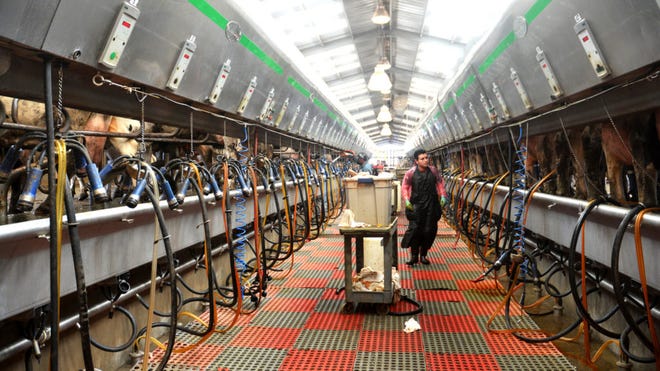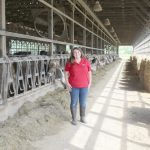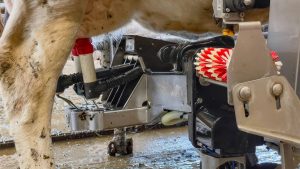
Prices have rebounded compared to a year ago, said Jennifer Spencer, Ph.D., AgriLife Extension dairy specialist, Stephenville, and demand continues to be high for milk and milk products from cheese to ice cream.
Spencer said Texas has surpassed New York to become the nation’s fourth-leading milk producer with 1.32 billion pounds. But a lack of processing plant capacity has limited dairy expansion.
“It’s good and bad news,” she said. “Prices are good, but processors are overloaded with milk and a tiered program has been implemented giving producers an allotment of milk production before receiving a discount, so they’ve in turn had to pull back on production for now.”
Spencer said producers would like to be maximizing on the excellent crop production fueled by rains this spring but will have to wait.
Ongoing expansion of the state’s processing capacity with a new cheese processing facility in Amarillo will help to reduce the duration of the allotment program, she said. Spencer suspects the state will quickly move into third place ahead of Idaho for U.S. dairy production once processing volume allows Texas dairy producers to operate at maximum capacity and/or expand.
Texas dairy outlook good after ugly year
The good news is the Texas dairy industry overall emerged from more than a year of adversity, Spencer said. Unfortunately, some dairy operations didn’t. She said there were approximately 400 registered dairies in the state in 2019. There are now 351.
Texas dairy producers faced challenging times as COVID-19 disrupted the market destinations for milk, cheese and butter due to school and restaurant closures. Uniform milk prices fell after March and April and dropped from $19 per hundredweight to around $14 per hundredweight. For the year 2020, the average price was $15 per hundredweight.
Dairies also dumped around 14 million gallons and incurred losses of around $8 million in February as Winter Storm Uri brought the logistical chain from raw milk pick up to processing and product delivery to a virtual standstill.
Prices slowly recovered as the pandemic wore on but have yet to reach pre-pandemic levels – around $19 per hundredweight, Spencer said. Milk prices were around $17 per hundredweight and could be poised to climb during the summer.
“There are a lot of creative milk products, which helps demand, but there is also that summer demand for ice cream,” she said. “That and the drop in milk production by cows during the summer, and we could see prices climb a bit more.”
Increased export demand adds another element to price forecasts being good for producers, Spencer said, adding the future for Texas dairy production appears much brighter than in 2020.
“There have been positive developments lately,” she said. “Once the additional processing is available, it’s possible that Texas could move into third place, but the two top producers – California and Wisconsin – are way ahead. But, over the next decade with all the growth in the Panhandle, who knows?”
Weekly Ag Report
• Panhandle: Temperatures were in the upper 90s and beyond 100 degrees. Widely scattered thunderstorms were reported. Soil moisture levels throughout the district were short to adequate. Pastures and rangelands, wheat, oats, cotton, corn and sorghum were all in fair to good condition. Wheat was maturing quickly due to heat and wind.
• South Plains: Fields were still drying out after more rainfall. Several producers reported hail damage to emerging cotton. As the fields dried out many were able to finally make a first cutting of hay. Producers were able to finish baling triticale and other cool-season forages and started planting cotton. Some fields may be planted in sorghum if producers cannot access them before the cotton planting window closes. Cattle were in good condition, and pastures were thriving with the recent moisture.
• Rolling Plains: Rains ranging from 2-6 inches fell in Cottle County, while Palo Pinto County reported up to 2.5 inches and Wilbarger County reported 1-2 inches. Many counties reported drier conditions. Producers were still waiting to get into fields. Pastures greened up significantly. Conditions were hot and humid as temperatures reached 100-plus degrees. Cotton, sorghum, hay grazer and Sudan grass were planted. Corn and sorghum looked good. Wheat harvest was ramping up in areas dry enough to access fields. Producers in Wilbarger County reported 30-90 bushel-per-acre yields of wheat. Grasshoppers were starting to show up. Some producers were cutting hay, and bales were mostly a mix of cool-season and warm-season grasses. Coastal Bermuda grass should take off soon. Cattle looked good, and calves were making good gains. Stocker calves looked good as well with plenty of grazing.
Milk production in the Panhandle/South Plains
Dallam County
• Number of Producers: 5
• Percentage of Total: 1.423%
• Pounds of Milk: 52,327,770
• Percentage of Total (Milk): 4.25%
• Number of Cows: 24,918
• Milk Processors: Hilmar Cheese Co.
Hartley County
• Number of Producers: 18
• Percentage of Total: 5.13%
• Pounds of Milk: 231,089,273
• Percentage of Total (Milk): 18.77%
• Number of Cows: 110,043
Moore County
• Number of Producers: 9
• Percentage of Total: 2.56%
• Pounds of Milk: 93,404,185
• Percentage of Total (Milk): 7.59%
• Number of Cows: 44,478
Deaf Smith County
• Number of Producers: 14
• Percentage of Total: 3.99%
• Pounds of Milk: 96,387,035
• Percentage of Total (Milk): 7.83%
• Number of Cows: 45,899
Parmer County
• Number of Producers: 16
• Percentage of Total: 4.56%
• Pounds of Milk: 116,518,302
• Percentage of Total (Milk): 9.46%
Number of Cows: 55,485
Castro County
Number of Producers: 14
Percentage of Total: 3.99%
Pounds of Milk: 121,855,904
Percentage of Total (Milk): 9.9%
Number of Cows: 58,027
Hale County
Number of Producers: 6
Percentage of Total: 1.71%
Pounds of Milk: 51,251,417
Percentage of Total (Milk): 4.16%
Number of Cows: 24,405
Lamb County
Number of Producers: 13
Percentage of Total: 3.7%
Pounds of Milk: 86,661,244
Percentage of Total (Milk): 7.04%
Number of Cows: 41,267
Milk Processors: Select Milk Producers
Bailey County
Number of Producers: 10
Percentage of Total: 2.857%
Pounds of Milk: 49,565,127
Percentage of Total (Milk): 4.03%
Number of Cows: 23,602
Information from: milk4texas.org























